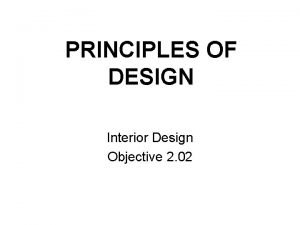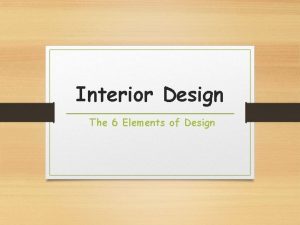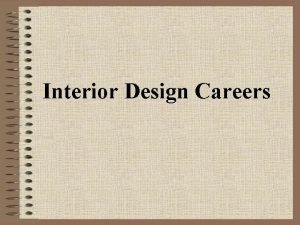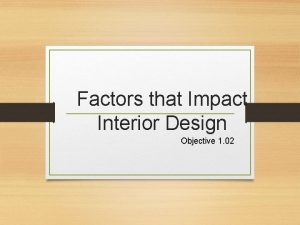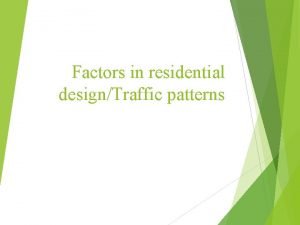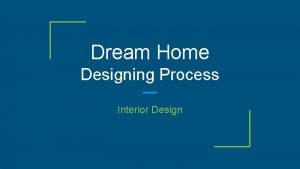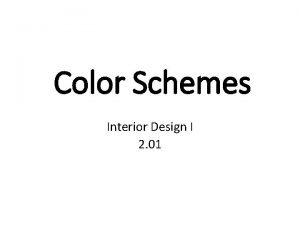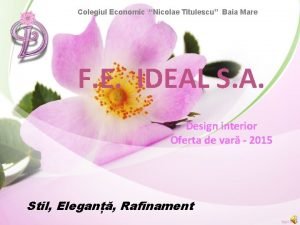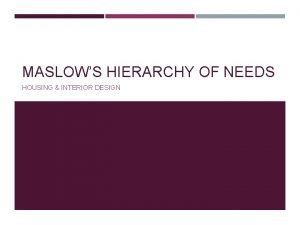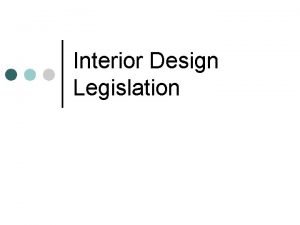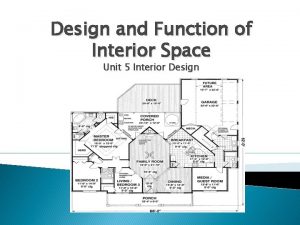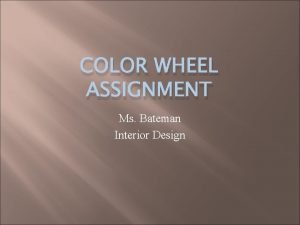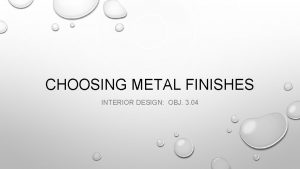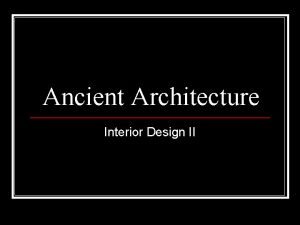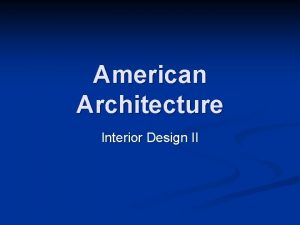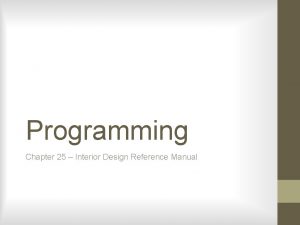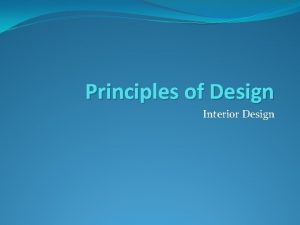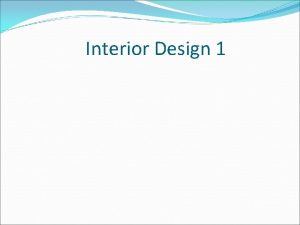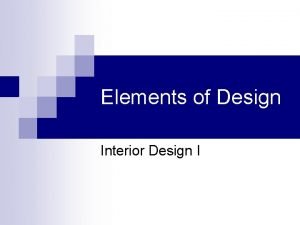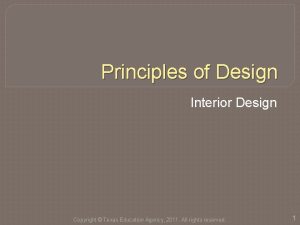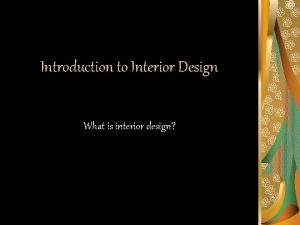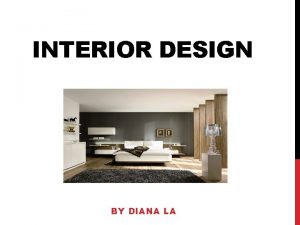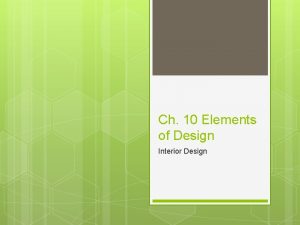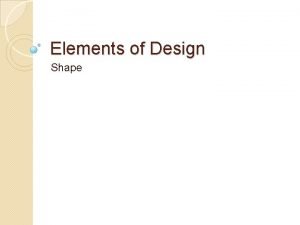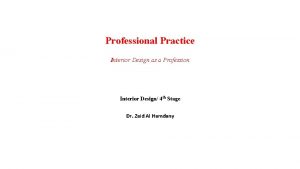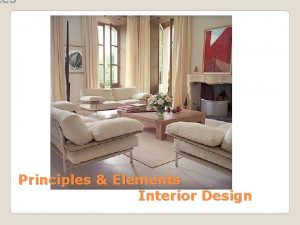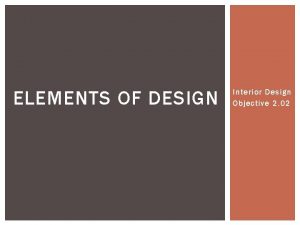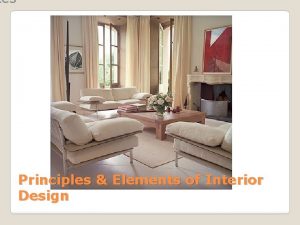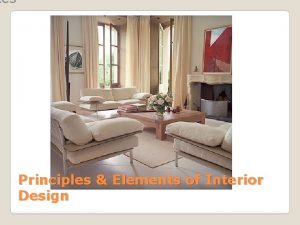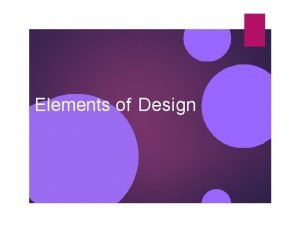Elements of Design Interior Design Copyright c Texas






















- Slides: 22

Elements of Design Interior Design Copyright (c) Texas Education Agency, 2011. All rights reserved. 1


Line �Most basic element of design �Shows direction �Takes your eye from one place to another. �Types of line: • • Horizontal Vertical Diagonal Curved Copyright (c) Texas Education Agency, 2011. All rights reserved. 3

Horizontal Line �Parallel to the ground. �Make a space appear wider. �Communicates: • • Peace Relaxation Calmness Restfulness Copyright (c) Texas Education Agency, 2011. All rights reserved. 4

Vertical Line �Perpendicular to the ground. �Draw the eyes upward. �Create height. �Communicates: • • • Height Strength Dignity Formality Permanence Stability Copyright (c) Texas Education Agency, 2011. All rights reserved. 5

Diagonal Line �Communicates activity. �Level depends on the degree of the angle. • Creates movement, interest and excitement. • Create a feeling of transition from one place to another. Copyright (c) Texas Education Agency, 2011. All rights reserved. 6

Curved Line �Curved lines seem softer than straight lines. �Create natural, soothing and flowing movement. �Communicate: • Softness • Freedom • Openness Copyright (c) Texas Education Agency, 2011. All rights reserved. 7

Form �The physical shape of objects. � 3 dimensional �Has height, width and depth � 4 types of form: • • Realistic Form Abstract Form Geometric Form Free Form Copyright (c) Texas Education Agency, 2011. All rights reserved. 8

Realistic Form �Looks like the real thing. �Communicates: • Lifelike • Traditional • Familiar Copyright (c) Texas Education Agency, 2011. All rights reserved. 9

Abstract Form �Alters a recognizable object. �Communicates: • • Contemporary Changing Creative Artistic Copyright (c) Texas Education Agency, 2011. All rights reserved. 10

Geometric Form � Uses geometric figures to create form. � Squares, rectangles, circles, etc. � Examples: Square tables & lampshades. � Communicates: • • Order Organization Planning Tailored look Copyright (c) Texas Education Agency, 2011. All rights reserved. 11

Free Form �Random & flowing. �Found in nature. �Plants, stones and wood. �Communicates: • Freedom • Untraditional • Unfamiliar Copyright (c) Texas Education Agency, 2011. All rights reserved. 12

3 Rules of Form 1. Form follows function. Consider function before form. 2. Related forms are more pleasing to the eye than unrelated forms. 3. A gradual change in form smoothly directs the eye. Too many changes in form is confusing Copyright (c) Texas Education Agency, 2011. All rights reserved. 13

Space � The area around a form. � The area in a form (like a room). � Small space communicates: • Cozy • Intimate • Comfortable � Large space communicates: • Openness • Grandeur • Freedom Copyright (c) Texas Education Agency, 2011. All rights reserved. 14

Altering Spaces � To make large spaces smaller • Divide the space into separate areas � To make small spaces larger: • Expand a window area • Use mirrors • Remove walls Copyright (c) Texas Education Agency, 2011. All rights reserved. 15

Mass �The amount of pattern or objects in a space. �How crowded or empty the space � 2 types of mass • High Mass • Low Mass Copyright (c) Texas Education Agency, 2011. All rights reserved. 16

High Mass �Space that is crowded. • Fabric with many patterns or lines • A room with many items in it �Communicate: • Impression of formality • Weightiness • Cluttered Copyright (c) Texas Education Agency, 2011. All rights reserved. 17

Low Mass �Simple and sparse space. �Only essential items in the space. �Communicates: • Clean • Airy • Functional Copyright (c) Texas Education Agency, 2011. All rights reserved. 18

Texture �The way a surface feels or appears to feel. �Two kinds of texture: • Tactile • Visual Copyright (c) Texas Education Agency, 2011. All rights reserved. 19

Tactile Texture �The way the surface feels to the touch. �Rough to the hand. �Create a casual feel. �May make a room appear smaller Copyright (c) Texas Education Agency, 2011. All rights reserved. 20

Visual Texture �Texture that you see but can not feel. �Smooth to the hand. �Communicate elegant feel. an �May make a room appear larger Copyright (c) Texas Education Agency, 2011. All rights reserved. 21

Color �May be the most impactful element of design. �One of the first design decisions made. �Color creates the mood of a room. �Color may leave a lasting impression. �Color will be discussed at length in the next lesson. Copyright (c) Texas Education Agency, 2011. All rights reserved. 22
 Elements and principles of interior design ppt
Elements and principles of interior design ppt A decorative design or pattern
A decorative design or pattern Abstract interior design
Abstract interior design Radiation interior design
Radiation interior design Introduction to interior design
Introduction to interior design The 6 elements of design
The 6 elements of design Interior design goals
Interior design goals Jacobean interior
Jacobean interior Human factors interior design
Human factors interior design Interior designer ppt
Interior designer ppt Traffic patterns interior design
Traffic patterns interior design Interior design checklist
Interior design checklist Achromatic color scheme room
Achromatic color scheme room Liceu economic baia mare
Liceu economic baia mare Maslow's hierarchy of needs interior design
Maslow's hierarchy of needs interior design Title act vs practice act
Title act vs practice act Guest circulation pattern
Guest circulation pattern Interior design homework assignments
Interior design homework assignments Interior design metal finishes
Interior design metal finishes Ancient egyptian interior design
Ancient egyptian interior design Nnnn ranch
Nnnn ranch Interior design programming
Interior design programming Opposition in interior design definition
Opposition in interior design definition



